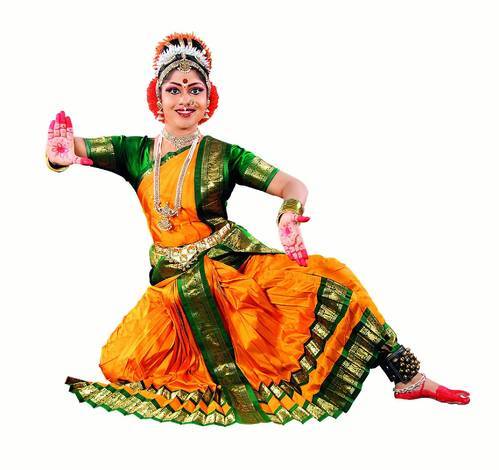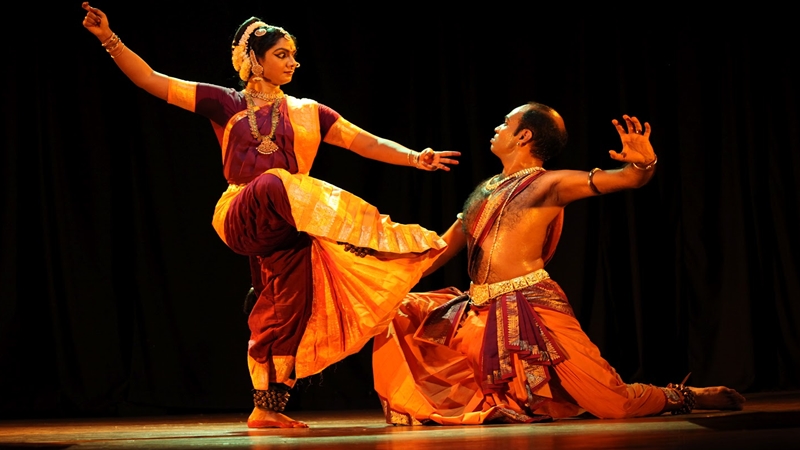- Home
- Culture of India
- Indian Dances
- Kuchipudi
Kuchipudi - Indian classical dance
Kuchipudi is one of the eight classical dance forms of India. It is the classical dance drama form that originated from a village called Kuchelapuram in Krishna district of Andhra Pradesh. Kuchipudi is a dance drama form that includes graceful movement of hand and foot and hence can be said as a perfect balance of Nritta (pure dance), Nrittya (dance with emotions) and Natya (drama). It also includes graceful facial expressions.
Kuchipudi is typically performed by both male and female dancers, although historically it was dominated by men. The dance style is characterized by its fast footwork, which involves complex rhythmic patterns and intricate movements of the ankles and feet. In addition to footwork, Kuchipudi also features graceful movements of the hands, arms, and upper body.
Kuchipudi evolved as a religious dance form that was performed in temples and the theme for the dance was based on Lord Krishna. Initially the dance was performed by Brahmin men called as Bhaghavathalu, but now the dance is dominated by women, and it has been reduced to more like dance than like dance drama.
Kuchipudi usually begins with a prayer. Then each dancer is introduced according to their role. Later they start with pure dance ( nritta). This is later followed by nritya where all the graceful movements of the dancer begin along with the music and musical instruments. Some of the instruments used are mridangam, cymbals, veena, flute, and tambura.
History of Kuchipudi dance
Like other dance forms, even Kuchipudi also has its roots in ancient Hindu Sanskrit text Natya Shastra. Natya Shastra has around 6000 verses and 36 chapters. It is a Sanskrit text based on performing arts accredited to Bharata Muni. It is presumed that the full version was first completed between 200 BCE to 200 CE but also varies from 500 BCE to 500 CE. Bharatha muni also mentions a graceful movement called Kaishiki vritti and a raga called Andhri from Andhra region. This raga is related to Gandhari and Arsabhi.
It is believed that kuchipudi was in existence around the 10th century. Inscriptions written on copper called Brahma melas are found and also found in the texts of Machupali Kaifat of the 15th century. These dance drama performances related to Shaivism were called Brahmana Melas or Brahma Melas. Brahmins performed this art during the medieval era. Vaishnavism, which grew in the 2nd century, probably adopted this style of dance performance. The devotees were called as Bhagavatulu in Andhra region and Bhagavatars in Tamil region.
While in Andhra Pradesh this art evolved as Kuchipudi but in Tamil Nadu it came to be known as Bhagavata Mela Nataka. According to Sasika Kersenboom both the Telugu Kuchipudi and Bhagavata Mela Nataka of Tamil Nadu are closely related to Yakshagana from Karnataka. All three involved dance drama traditions but in different costumes. Further Manohar Varadpande believed that by the 13th century Ganga dynasty rulers from Kalinga patronized art forms according to 12th century Sanskrit scholar Jayadeva particularly the Gita Govinda. It is believed from the sources that Vardpande encouraged many poets and dance drama troupe to include Radha Krishna themes into Kuchipudi which was locally called as Vaishnava Bhagavatulu.
The present version of Kuchipudi is accredited to Tirtha Narayanayati who was a sanyasin of Advaita Vedanta in the 17th century and to his disciple Sidhyendra Yogi. Narayanayati authored Sri Krishna Leela Tarangini. The composition dealt with the life of lord Krishna and 12 Tarangams which included 302 slokas, 153 songs and 31 choornikaas. His disciple also wrote a play Parijatapaharana also known as Bhama Kalapam. But the path was not easy for Yogi to find performers for his play. He then went to Kuchelapuram which was his in-law's village and executed the play once a year.
During the 16th century Kuchipudi was given importance by the rulers of Vijayanagar Empire. It is believed that Kuchipudi was performed in the courts of Vijayanagara Empire. However, with the invasion of Islam and the formation of Delhi Sultanates recreated a major turmoil in the political stability. The fall of Vijayanagara Empire to Delhi Sultanates in 1565 who destroyed temples in the Deccan cities. Around 500 artists left the place and took shelter under Hindu king Achyutappa Nayak near Tanjore. The place where these families settled grew into modern Melattur near Tanjore.
By 1678, the last Shia Muslim Sultan of Golconda saw the Kuchipudi dance form and was so impressed that he granted them lands in Kuchipudi village. Later Aurangzeb took over the control by overthrowing the Shia Sultanate. He banned all the public performance of any art, music and dance forms further destroying the Indian art during Mughal rule.
Revival
Kuchipudi saw a decline around the late 17th century and during the colonial period. Most of the dance form declined during colonial rule. However, during the beginning of 20th century with great efforts from Vedantam Lakshmi Narayana Shastri, Vempati Venkatanarayana Sastri and Chinta Venkataramyya Kuchipudi saw a revival. The three encouraged people to learn Kuchipudi and also encouraged Indian women to perform solo dances of Kuchipudi.
Repertoire and Sequences in Kuchipudi
Kuchipudi is a team and solo performance which includes extensive facial expressions and hand and foot movements. A complete Kuchipudi consists of nritta and nritya and the play may include natya. Nritta may include darus, jatis, tirmanas and tillanas, while nritya may include padams, varnams, shabdams and shlokas.

The dance starts with a prayer and is usually performed during evenings. The postures of Kuchipudi and Bharatanatyam are quite similar such as the half setting position called Aardhamandali. But however, there is a subtle difference between the two dances. The conductor of the performance introduces each character of the play and remains for the whole of the play by entertaining the crowd.
Even kuchipudi follow three performance categories like Nritta, Nritya and Natyam. Nritta is a pure dance form where importance is given on form, speed and pattern. Nritya is slower body movements and expressions that try to keep the audience engrossed in the dance and the theme of the dance. It is the most important part of the play. The performer uses hand mudras and facial expressions to communicate the story to the audience.
Natyam is a group performance but can also be a solo performance. Once the prayer is done and the actors are introduced on the stage Nritta performance starts, later comes the Nritya which is the most important part of the dance. Nritta includes darus, Jattiswaram, tilanas, tirmanas. While nritya includes padams, varnams, slokas and shabdams.
Kauvtvams is another important dance performance in Kuchipudi which is done in the form of Nritta or Nritya to different talas. At the end the dancers show a bird, flower or Ganesha to the audience. The musical instruments that are used are Mridhangam, Veena, Flute, tambura and the music being Carnatic music sung in Telugu Language.
Costume for the dance

The costume of the dancer includes a saree with pleats in front from the waist with heavy jewellery worn on head, hair, ear and neck. Lots of flowers are also worn on the head with very grand make up on the face. A ghungroo is also worn. Further her jewelry may include hair jewelry, ear, nose, armlets, necklaces and ghungroo. The male dancers wear a dhoti from the waist to downwards called Angavastra. A waist belt made up of gold or brass is worn by the dancers. A big bindi is kept on the forehead of the dancers. Her eyes are adorned with kajal. Sometimes special costumes are worn for particular characters, plays like a peacock feathered crown is worn while doing the Lord Krishna role.
Famous Dancers
Some of the important musical instruments used for Kuchipudi are cymbals, mridangam, violin, flute and thambura. It is led by the chief musician also known as the conductor who is called as Sutradhara. The conductor may also sing or someone else can also sing.
Some famous dancers include Yamini Reddy, Kausalya Reddy, Lakshmi Narayan Shastri and many more. Some of the other eminent dancers include Raja and Radha Reddy, their daughter Yamini Reddy, Bhavana Reddy, daughter of Raja Kaushalya Reddy, Lakshmi Narayan Shastri and many more.
Update on coronavirus in India
Affiliate Disclosure:
If you make any purchase via a link on this site, I may receive a small commission with no added cost to you.












